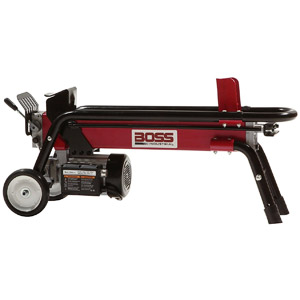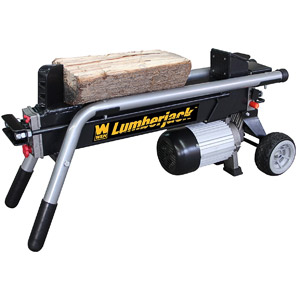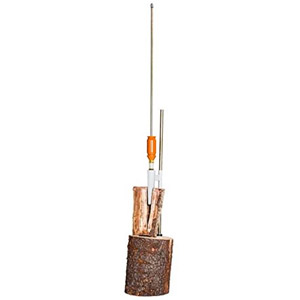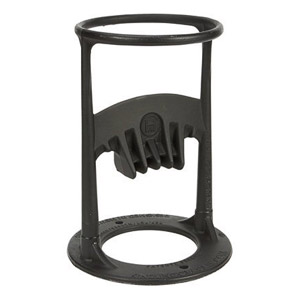 Log splitters come in handy whenever you need to deal with a large amount of wood. While using an axe or sledge and wedge is definitely a possibility, a splitter make the job a lot easier, safer and faster.
Log splitters come in handy whenever you need to deal with a large amount of wood. While using an axe or sledge and wedge is definitely a possibility, a splitter make the job a lot easier, safer and faster.
Here we present you our most recommended models – with ratings, prices and reviews:
Our most recommended: The most popular electric wood splitter currently on the market – compact, with one-handed operation and good power.
Cheaper: Best log splitter for the money. Compact, easy to move and store but with slightly less power and a two-handed operation.
Manual: There is no engine to do the work for you – on the other hand this it’s a lot cheaper, easy to use and doesn’t require much labor.
Smart Splitter: An interesting concept – great for small to medium logs or for making kindling. It’s safe, easy to use, only requires a large log as a base.
For kindling: The best tool for making kindling you can find – safe, easy to use and fast. But not for pieces thicker than 6″.
Comparison with other models:
| Model | Type | Price | Our rating |
Splitting force | For | Operation | Weight | Max log length | Cycle time (approx.) |
|---|---|---|---|---|---|---|---|---|---|
 Boss Industrial ES7T20 Boss Industrial ES7T20 |
Electric | $610.00 | 7 tons | one-handed | 106 lbs | 20.5″ | 10-18 seconds | ||
 WEN 56206 Lumberjack WEN 56206 Lumberjack |
Electric | — | 6 tons | two-handed | 100 lbs | 20.5″ | 14-25 seconds | ||
 Powerhouse XM-380 Powerhouse XM-380 |
Electric | — | 7 tons | one or two-handed | 104 lbs | 20.5″ | 11-18 seconds | ||
 Champion 7-Ton Champion 7-Ton |
Gas | 7 tons | one-handed | 143 lbs | 19″ | 10-20 seconds | |||
 Champion 25-Ton Champion 25-Ton |
Gas | $2,398.33 | 25 tons | one-handed | 430 lbs | 24″ | 12 seconds | ||
 Sun Joe LJ10M Sun Joe LJ10M |
Manual | $259.00 | up to 10 tons | manual | 87 lbs | 18″ | 20-40 seconds | ||
 Logosol Smart-Splitter Logosol Smart-Splitter |
Manual | $133.00 | – | manual | 19.84 lbs | – | depends on user | ||
 Kindling Cracker Kindling Cracker |
Manual | $80.99 | – | manual | 10 lbs | up to 14″ approx. | depends on user | ||
 Quality Craft Foot-Operated Log Splitter Quality Craft Foot-Operated Log Splitter |
Manual | 1.5 tons | foot-operated | 23 lbs | 18″ | – | |||
 Anaconda 878 Slide-Hammer Anaconda 878 Slide-Hammer |
Manual | Check here: | – | manual | 13.9 lbs | – | depends on user |
How to choose a wood splitter?
What is the best log splitter? That depends on the circumstances, you would not want a powerful and expensive machine if you need to split wood only once a year. Or if you need to use the splitter in the woods or at a cabin where there is no electricity, an electric unit would be useless of course.
We can say there are three main types:
- Electric – the most popular type for homeowners. They provide enough power for some occasional splitting (for example 2 cords of wood per winter) and the price isn’t too high. They offer mostly 6 or 7 tons of force and (according to the users) some of them can tackle even 17″ thick logs. The only problem is that you have to work within the range of an extension cord – but they are also less noisy, require less maintenance and you can use them even indoors as there are no exhaust fumes.
- Gas powered – if need to split a lot of wood or deal with a particularly large or tough pieces, gas machines are the way to go – they simply offer the most power. Even 30 tons of pressure is not rare and these beasts will split anything you throw at them. They are also independent on electricity so you can use them even in the woods. On the other hand they are much more expensive and require a proper ventilation due to the fumes – so it’s not possible to use them indoors.
- Manual – there is no engine to help you with splitting so they are slower and not ideal for large logs. On the other hand they are a lot cheaper than the motorized units and even though they require some physical labor, they are less tiring than axe or sledge and wedge. So they are perfect if you need an inexpensive tool for a small amount of splitting or something to take with you for a camping trip.
So we advise you to start this way – think about how often are you going to use your splitter and how large would the logs be and decide which type will be the best option for you.
Do you need wood just for your fireplace or are you planning a log splitting business, selling wood to other people? Do you need to use it in the woods? Would you like to use it indoors as well? What about your neighbors, would a roar of a gas machine be too much for them?
 |
 |
 |
|
Pros:
Cons:
|
Pros:
Cons:
|
Pros:
Cons:
|
Renting a wood processor
Some people prefer to rent a powerful unit just once per year and do all the splitting in one day. And while that’s definitely a possibility, we would rather recommend you to buy an electric splitter instead. The price of these models isn’t that steep and you wouldn’t have to do all at once, risking ruining your back or upseting your neighbors by the constant noise.
What is a log splitter?
It’s a device designed to make splitting wood a lot easier, faster and safer.
Motorized splitters
While there are many types, the most common is the motorized hydraulic version where you simply put the log into a cradle and the engine drives a piston that pushes the log onto a stationary blade (or moves the blade itself onto the log). The wood is split in a few seconds with no effort from you at all.
These models are also equipped with small wheels so you can move them around more easily (their weight exceed 100 lbs). And the largest ones even offer a coupler for a ball hitch and can be towed by an ATV or UTV for example.
The most popular are electric and gas powered – we have already described their advantages and disadvantages above. Plus there also some less common types:
- Kinetic – the engine rotates a flywheel which then uses its energy to speed up the splitting.
- Machine mounted – these use the engine of a tractor or some other large machine so their power is just monstrous.
Why should I get a firewood processor?
Anybody can use an axe, right? So why invest in such expensive wood splitting machine?
The truth is there are many people who are simply not able to work with an axe or a wedge and sledge hammer – seniors, people with back pain or women for that matter. And while many love the rewarding feeling of working the old fashioned way using a splitting axe, you’ll save a lot of time and energy after switching to machine.
A typical cycle time of a motorized splitter is between 10 and 15 seconds so just imagine how many logs you are able to tackle in an hour. And all of that with minimal effort, no exhausted muscles, back ache or blisters on your hands – it’s just a lot easier on your body.
Safety
And while using a tree splitter is certainly safer than swinging an axe, there are safety measures you have to keep it mind, otherwise these tools can become pretty dangerous.
The most important thing is to keep your hands out of harm’s way, those 7 or more tons of force can be really devastating! So if you use one hand to stabilize the log, be very careful. Some machines even require both hands to engage the piston so there is no possibility your hands could enter the unsafe area.
A proper clothing is also important – boots, long pants, gloves, goggles against splinters and also an ear protection if you own a powerful gas model. Do not wear any jewelry, necktie or any other loose clothing that can be caught in the moving parts.
Also stay within the limitations of the particular splitter and do not try to cut through a log that is obviously too large for it. You never know what may happen, for example pieces of wood shooting in all directions, the machine collapsing or breaking etc.





